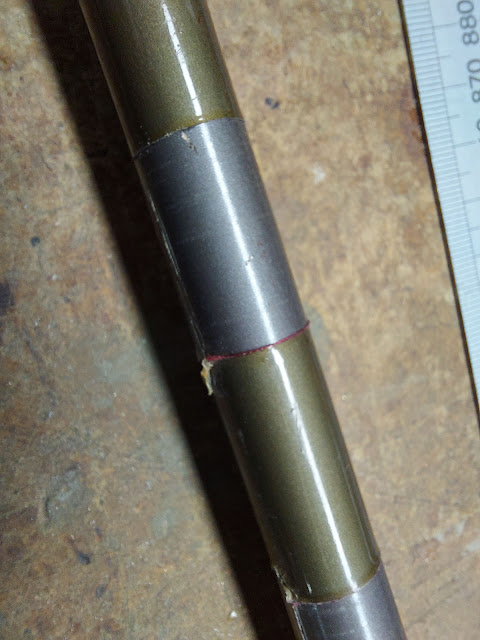ON THE BENCH - COLOUR
As a serial restorer of cane rods in poor condition, probably my biggest frustration comes when I have a rod that requires varnish removal. That may be because it is flaky or damaged itself or because the cane beneath requires work. Many old rods and poles have the most beautiful mahogany colour but that is not the colour of the cane, rather it is the yellowing of the varnish that one is seeing. Unless you are used to removing varnish it is hard to imagine the difference that age makes to vintage varnishes.
I have tried and am still trying to solve
this conundrum, how do I get that colouration back? Well I first tried tinting
the varnish with a compatible woodstain and that was pretty useless. No matter
how much stain I put in, the coats were too thin to make much difference. I
also tried the same idea with oil paint with similarly disappointing results.
Probably the most successful attempt I
have made so far has been on this rather ropey Lea pole. Bamboo does not take
stain all that well but the work done to it originally and a light scuffing
before the stain is applied will allow it to take. In this case I applied 3
coats of antique pine over one of brown mahogany. Before varnishing the colour
was much closer, the effect afterwards while being attractive enough, was not
by any means a match for the original yellowed, brown, varnish.
Staining the bamboo had given a darker
finish but it had highlighted the original makers toolmarks beacause they had
broken the hard enamel surface and the clear varnish allowed all that to show.
The original patinated varnish had become opaque with time and was in fact
hiding the cane beneath pretty much as paint would. For now, it is back to the
drawing board and I am pondering my next step which may involve adding oil to
the varnish, either linseed or teak perhaps. Shellac is something I have to
look into as I understand that may have been used originally by some makers,
This discolouration of old varnishes
causes other insurmountable issues for the amateur restorer. For a start it
totally changes the colour of whippings. Take the old black and white,
so-called jasper, thread so popular with rod builders in the middle of the last
century. That now appears, rather appropriately, black and dark yellow, jasper
being an old name for a wasp. It's pretty much impossible to replace an odd
ring here or there without it standing out like a sore thumb. For a full refurb
is no problem, obviously and very attractive it is too especially on a black
painted cane.
Things don't get any easier with fibreglass either. The recent restoration of a Hardy Gordon Carpquest turned into a total nightmare. Fibreglass rod blanks of the early seventies were often painted. No etch primers were used and now, 50 plus years later, that paint is often chipped and scratched.
Repainting the rod was no issue, the paint flaking off easily but of course that can't be done close to the butt transfers. So my newly refurbished rod ended up a beautiful silver grey with purple and black whippings with transfers on small islands of dark green.
Hey ho, my rods are to
be used so I'm not losing any sleep over it. It does niggle a bit though. Oh!,
and my Sealey Blue Match is green as well, so there you have it, yellowing
varnish looks great on cane, crap on fibreglass and drives this restorer mad.





Sealey Blue Match - your 1st rod Eric?
ReplyDeleteSealey Aquarius for my part.
I was going to say no, this was a recent purchase, but thinking about it, actually it might have been. One of a handful of rods that disappeared over the years and I've no idea what happened to them.
ReplyDelete